| 1 | Master of spontaneous bleeding |
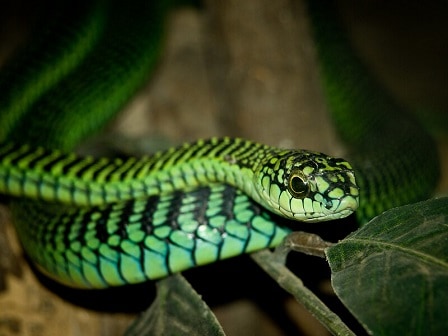
The boomslang (Dispholidus typus) is far from the deadliest snake in Africa. Only 7 deaths have been recorded since 1954, and it only delivers a minuscule 1.6-8mg of venom per bite. The darker side, however, is the gruesome way in which this snake kills its victims. The boomslang has venom which is not neurotoxic, but highly hemotoxic. It attacks red blood cells, and destroys the ability of the blood to clot. The result is that the victim slowly bleeds to death from every orifice in their body, including ones we can’t mention on a PG website.
Victims experience bleeding gums, followed by bloody saliva and urine. The tiniest of cuts will likely burst open again and start bleeding profusely. While this happens, the internal organs will also be bleeding and disintegrating. The process takes several days, and another disturbing characteristic is that boomslang victims feel fine for several hours. Boomslang venom has an unusually slow onset, which sometimes delays hospital treatment as well.
Many victims notice a yellow tinge in their vision, likely caused by tiny capillaries in the eyes leaking. Not surprisingly, the venom has a high-ranking LD50 toxicity score of 0.07mg, almost matching the black mamba’s 0.05mg.
| 2 | Feared by local villagers |
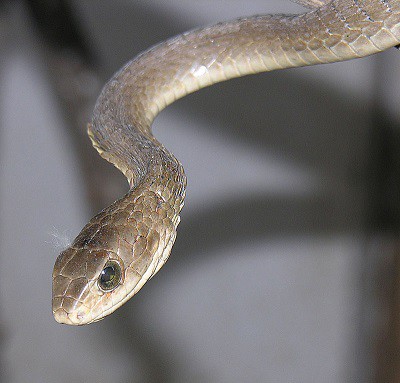
The boomslang is found across almost the entirety of Sub-Saharan Africa. The Congo rainforest basin is an exception, and the snake is absent from southwest Atlantic countries like Namibia, but the boomslang has a far larger range the black mamba. They stretch through the many small west African countries such as Ghana and the Ivory Coast, while on the Indian ocean coast further east they occupy Somalia and Kenya.
The boomslang has a fairly shy temperament. Nevertheless, locals have an intense fear of this snake, with Botswanans convinced that they’ll leap from their trees aggressively if you accientically walk beneath them. It’s said that if you park your car next to a boomslang tree, then that boomslang is guaranteed to slither through the window.
According to this reptile expert, the boomslang is the most feared snake of in all of Botswana. Nothing can shake the old fears; the locals remain superstitious even after being told that the only deaths over the last 50 years have been from poor handling. Reptile controllers are commonly summoned to rural gardens to deal with boomslangs in trees, which residents refuse to go near.
| 3 | Found in trees, but not rainforests |
The boomslang is mostly a tree-dwelling snake, with one synonym being the common African tree snake. They spend most of the day in these trees, slithering around the branches in search for prey, and their green scales give them immense camouflage.
Boomslangs are a diurnal snake, meaning that it’s possible to watch one moving along the branches in broad daylight. Boomslangs are capable of mating in their trees as well, and it’s extremely rare to see them in urban areas.
The big difference to other tree snakes though, such as the emerald tree boa of South America, is that boomslangs aren’t restricted to these cosy trees. The latter only ever descends to the ground in an extreme panic when pursued by eagles, but the boomslang is often seen crossing roads or even water in their unending search for prey. They actually prefer more sparsely forested areas, and are occasionally spotted in isolated trees in the very centre of fields. The boomslang is a much more flexible tree snake overall.
Boomslangs have one consistent rule though: they always drag their prey back to the tree before eating it.
| 4 | Feeds on chameleons |

Trees are essential for their hunting strategy as well, as boomslangs are experts at using their thin bodies to cross even thinner branches and sneakily cross over to the next tree. Their skills of balance and distance judgement are obviously immense, and these skills help them to find their main prey, which is the rare niche of dwarf chameleons.
This African chameleon also inhabits the high, thin branches of boomslang country. It’s about 15cm long, and its camouflage skills are just as impressive as other chameleons, becoming virtually indistinguishable from the bright green leaves nearby. However, it’s also a very slow species. This gives the boomslang an interesting game to play, as the boomslang is an active pursuer rather than an ambush snake. It can easily charge and catch up with dwarf chameleons, but snakes have very basic eyesight, seeing in colour but making out few of the subtlest details and shapes. Therefore, the determiner of boomslang success is monitoring its environment patiently rather than sheer agility.
As a whole, boomslangs will eat mammals occasionally, but frogs make up a higher proportion, and reptiles by far the highest. Another chameleon it eats is the flap-necked chameleon.
| 5 | Schmidt’s heroic sacrifice |
Karl Schmidt was a well-respected American herpetologist born in 1890, who named 200 species over the course of his life, including the Schmidt’s reed snake in Malaysia. In 1957, he was working at Chicago’s Lincoln zoo, when somebody brought him a sack containing a young snake. Schmidt peered in and instantly identified the snake as a young boomslang.
Dispholidus typus is part of the rear-fanged snake family, and at the time, this family was collectively believed to be harmless. Schmidt reached in and pulled the snake out with his bare hands, but instantly received a pinprick bite on the thumb. Schmidt dismissed the bite, particularly given that it was a tiny juvenile snake. He carried on his work as normal, and happily made notes as the first, mild symptoms appeared.
The next day, his condition worsened dramatically, but Schmidt kept on jotting down the soon-to-be fatal symptoms. Hours before his death, Schmidt was asked whether he wanted medical care, but he refused so that he could continue to record the natural progression of the symptoms. Ultimately, Schmidt died from the baby boomslang bite, recording his symptoms almost to the very end. He was 67 years old.
| 6 | Shy, but not cowardly |
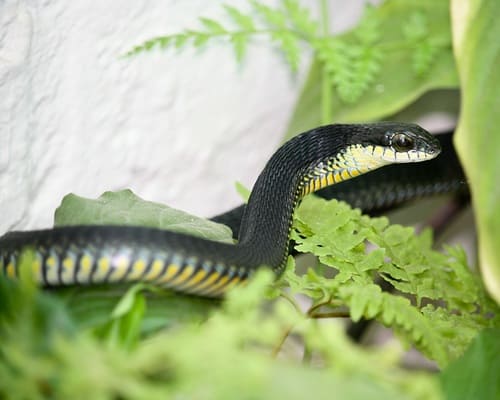
The main reason why the boomslang kills so few people is its shy nature. Despite folk beliefs, there are no cases of boomslangs swinging down from trees to attack people. Boomslangs can disappear in the blink of an eye if spooked – they’re said to be extremely difficult to capture.
If they do stand their ground, then their first warning display is to inflate their throat with their head held high. This is similar yet different to cobras, as boomslangs expand the throat itself rather than compress their ribs (which forces the throat outwards in cobras). The next intimidation technique is to move their tongue up and down slowly and rhythmically, as though licking their lips, all while maintaining unnerving eye contact. If the aggressor foolishly ignores this, then the boomslang will finally bite.
The final safety buffer is the species’ mouth shape. Boomslangs have the ability to open their mouth 170 degrees, which sounds impressive when you first hear it. But this is actually to compensate for being rear-fanged, with their venom-injecting teeth at the back of their mouth. Consequently, the boomslang isn’t trigger happy, and is much more reluctant to get bitey. Boomslangs have to perform a patient chewing motion just to enveomate prey like chameleons.
| 7 | May appear in Christmas trees |
In December 2021, a tale of horror did the rounds which probably didn’t extinguish any of the age-old fears. Rob Wild was a British expat living in the Western cape of South Africa, for whom setting up the Christmas tree was a beloved yearly tradition. His family would handmake their own decorations and cover the tree with endlessly complex displays with all the imagination possible poured into them.
That year, as the satisfied family admired the completed tree, they noticed that the family cats were watching with equal keenness. The next minute, mayhem erupted as the head of a boomslang snake poked out from the pile of presents below.
Everyone leapt back and Wild’s wife spoke a few unrepeatable words in Spanish. As the boomslang slithered around the tree, Wild called in a snake catcher, who secured the boomslang and measured its length as 4.4-4.9 feet.
And the final plot twist? The tree wasn’t even real – it was an artificial tree from order, as Wild’s wife was dissatisfied with the thickness of the local trees from the western Cape. How the snake reached the tree was never established.
| 8 | Males versus females |
A special feature of the boomslang species is that sexual dimorphism is much higher than other snakes. Boomslangs take on the pheasant or pigeon model where the females are a dull colour, while the males are bright and colourful.
Females are brown-green, with a light brown underbelly, with no real change at their head. Males are much more striking, with neon green scales that contrast sharply with black marks, or even blue marks. The contrast begins at birth, as females are a light brown while male hatchlings are grey speckled with blue. The black mamba, for example, is a species with almost no sexual dimorphism.
Male boomslangs also become hyper aggressive during the mating season from early July to October. They’re well known for their brutal ritualistic wrestling with other males, sometimes causing foliage to sway back and forth with loud scuffling sounds, as huge flocks of birds suddenly fly away in distress. Only one male can win these duels, and the prize is great: the undisputed right to mate with all female boomslangs in the area.
| 9 | Bulbous orbs for eyes |
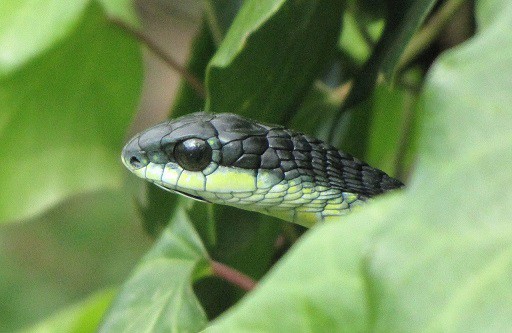
Boomslangs are an average length snake, at 1.2 to 1.5 metres on average. They’re not a thick-bodied snake like their neighbour the puff adder (which can kill prey with the sheer force of its jump) – instead, they’re thin in order to cross branches. The only unusually large part is their eyes. These are large, round and black, and can sometimes look like smooth, emerald-coloured crystal balls when reflecting the greenery of the foliage.
These eyes are the easiet way to distinguish them from nearby tree-dwelling snakes. The pupils also have unique keyhole-shaped pupils, as opposed to the normal round or vertical. Boomslang eyes are so massive that they give the snakes binocular vision as well. It’s possible though not confirmed, that these giant eyes evolved in response to the dilemma of the chameleon’s camouflage.
One clear sign that a boomslang is a juvenile is their throats, which are bright yellow with black specks. A tip for spotting the species as a whole is that their body is thin and whip like, while their head is stubby and egg shaped.
| 10 | The Harry Potter connection |
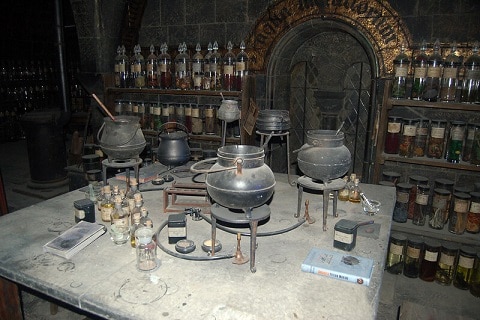
If you’re a Harry Potter fan, then something might be stirring at the back of your mind right now. I’ll give you one more second to think about it…
…that’s right, the boomslang was one of the ingredients of the polyjuice potion made by the three heroes in the second book, The Chamber Of Secrets. This wasn’t a typical potions ingredient used by students of Hogwarts, and could only be accessed by burglarising Professor Snape’s not-so-tightly locked store cupboard. The boomslang skin was to be shredded, and when mixed with other ingredients, would allow the drinker to turn themselves into whoever they wanted, if they placed a tiny stolen piece of that person in the mixture as well. The various Chamber Of Secrets videogames from 2002 made entire levels out of raiding Snape’s store cupboards.
The other ingredients, meanwhile, were both real and imaginary. Fluxweed is a family of plants across Europe, and lacewings are an insect family with 18 different species living in the UK. Bicorn horn is sourced from the depths of mythology, as the bicorn was a sentient, cow-like creature which supposedly shed its valuable horn just twice a year and had a habit of eating good-natured husbands.

Pingback: Angthong National Marine Park
I have read that when they were thought to be non-venomous, Boer farmers let their children play with them as pets.